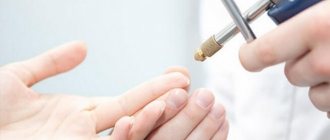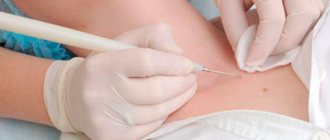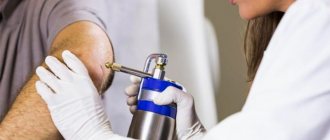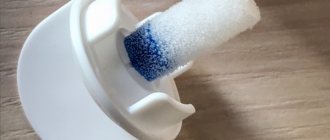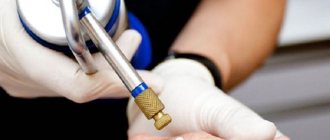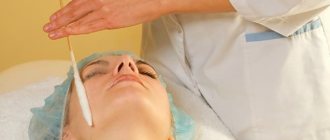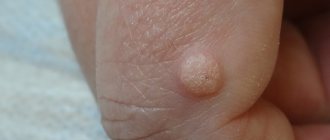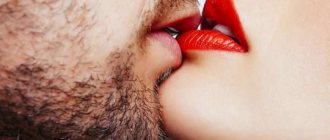Spine removal with liquid nitrogen is the destruction of a wart by quickly freezing the affected tissue. The painful formation occurs as a result of infection with certain strains of HPV and causes discomfort and pain. It is better to get rid of this unpleasant phenomenon in the early stages, to prevent the growth of pathological cells.
Causes
Such growths have a viral etymology. However, infection with papillomavirus manifests itself in the form of skin defects. Often the patient is unaware that he is a carrier of HPV. The virus can “dormant” from several months to several years. As long as the body's defenses are sufficient to resist infection. Decreased immunity and the appearance of unwanted growths are provoked by factors such as:
- Past respiratory disease;
- Hormonal changes;
- Exacerbation of chronic diseases;
- Physical or mental stress;
- Insomnia;
- Chemotherapy;
- Taking steroids and antibiotics.
The risk group includes people who neglect foot hygiene, visit saunas, swimming pools without rubber slippers, use other people's bath accessories, and try on shoes in a store without a nylon stocking.
The appearance of a spine or other neoplasm requires mandatory consultation with a specialist. Although most people repeatedly encounter warts in themselves or their loved ones and believe that they can make a diagnosis on their own, this is not entirely true. Only a qualified specialist can make an accurate diagnosis, eliminating oncogenic risks and offer the most effective way to get rid of growths on the legs.
Nitrogen removal efficiency
Spica is a viral papilloma that occurs against the background of decreased human immunity due to the presence of HPV in the body. It looks like a flat growth, mainly on the legs or arms with black spots all over the surface. After infection, the virus, being in a suppressed immune state, does not make itself known. When the body’s defenses are weakened, it begins to multiply in cells, mutate, and increase blood flow to the site of localization. Excessive growth of infected mutated cells puts pressure on surrounding tissues, as a result of which a person experiences pain when pressing on the papilloma.
Cryodestruction allows you to remove viral defects on the skin of the palms, soles, and fingers the first time, if they have recently appeared and do not have a large area of distribution. If the roots of the wart have penetrated deep into the dermis, several procedures will be required to burn them out.
Getting rid of spines involves destroying the top layer of the growth, the root that penetrates the skin, and the vessels that feed the formation. If the impact on the neoplasm is insufficient, if part of it remains intact, the pathology will intensify and spread over a larger area.
Removal of spines in a specialized clinic
Medical centers offer their clients the following ways to combat unwanted growths on the legs:
- Laser destruction - wart tissue is evaporated layer by layer under the influence of a laser beam. An effective, safe, but expensive treatment method;
- Electrocoagulation - a high-frequency current closed in a loop cauterizes the neoplasm. A painful method that requires mandatory anesthesia;
- Surgical excision . Under local anesthesia, the surgeon uses a scalpel to cut out the growth and adjacent tissue. A very traumatic method, used only for overgrown growths or when there is a risk of malignancy of the formation;
- Cryodestruction - cauterization of the spine with liquid nitrogen.
Nitrogen burning technology
The liquid nitrogen treatment method does not require special preparation from the patient for the procedure. After examining the neoplasm, the doctor will numb the affected area for extensive lesions of the skin; for isolated rashes, the procedure can be performed without analgesics. With the help of cryotherapy, viral skin formations, other skin defects, and core calluses are successfully removed. Nitrogen acts instantly. Local or injectable medications are used as painkillers.
The technology for performing cryodestruction allows the use of a special directed nitrogen-spraying device, medical forceps or scissors, and a cotton swab with a long stem.
A special installation for spraying the drug is used in modern private clinics, and a cotton swab is used in government institutions. It cannot be said that the method of treatment with a spray installation is superior to the second method; the depth of impact is the same, but special equipment makes the procedure much more expensive.
The essence of the method of burning out the spine with liquid nitrogen is to expose the growth to ultra-low temperatures. To do this, the substance is converted into a solid state and stored in special thermal containers.
Before removing the growth, the area of skin around it is treated with antiseptic solutions and the procedure begins. The specialist immerses a cotton swab in a container with nitrogen and applies it with light pressure on the spine. If the procedure is performed with a spray installation, then a special applicator is applied to the lesion site, through which the substance is supplied, or nitrogen is remotely sprayed onto the papilloma through a nozzle, avoiding cold contact with healthy skin.
The substance comes into contact with the skin for 25-30 seconds, after which the doctor takes a break to assess the condition of the growth. After 30-60 seconds, the exposure of the spine to nitrogen is resumed if necessary. The procedure requires from 3 to 7 applications, the roots and cells mutated from the effects of the virus go deep into the skin. To remove papilloma permanently, it is necessary to destroy all cells and vessels feeding the defect with cold.
In places where there is increased friction of the papilloma on shoes or clothing, if the wart is old and extensive, an additional visit to the doctor will be required to remove it no earlier than a month after the wound has healed.
Removing spines with nitrogen
Cryodestruction is the most popular way to combat growths on the foot. The insidiousness of the spine is the discomfort it can cause to its “owner” when walking. The growth of a wart in depth leads to pinching of nerve endings and the appearance of pain.
Most often, the spine is located on the pads or at the base of the fingers, as well as on the heels. When a doctor burns the spine with liquid nitrogen, the patient may experience discomfort. This is due to the need for additional pressure on the growth and the duration of the cryodestruction procedure.
Removal of benign tumors with liquid nitrogen
Fibroepithelial polyps
Fibroepithelial polyp (papillomas) are benign neoplasms on the skin in the form of wart-like growths, rising above the level of the skin, with a wide base or on a stalk, grayish or brown in color, with a diameter of 0.3 - 1.5 cm or more, round or irregular in shape. Most often they are located on the neck (along the lateral surface) and in large folds. The surface of papillomas is villous or covered with easily detachable horny masses.
Fibroepithelial polyps occur in 50% of the world's population, and in women during pregnancy they increase in number and size. In pregnant women, these tumors often appear on the nipples, which is dangerous for breastfeeding for the unborn child.
Seborrheic keratosis
Seborrheic keratosis (syn.: seborrheic wart, senile wart, basal cell papilloma) is the most common benign skin tumor. Usually develops in middle and old age from the epidermis. Its pathogenesis is unclear, but it is believed that this lesion develops from cells of the basal layer of the epidermis or keratinocytes of the most superficial part of the hair follicle and is not associated with human papillomavirus. In accordance with modern ideas, there is no connection with solar radiation. It occurs predominantly in elderly and senile people, but is often observed in young people, equally often in men and women.
The tumor develops very slowly, sometimes over several decades. Initially, a limited spot of yellowish or brown color appears, which gradually increases, sometimes reaching 4-6 cm or more in diameter. The surface of the stain is gradually covered with greasy crusts, which are easily removed. Over time, the crusts become denser, but often retain a greasy surface, riddled with cracks. The thickness of the crusts can reach 1-2 cm. The tumor becomes yellow-brown, dark brown or black. Localization can be very diverse. Lesions can be single or multiple. In rare cases, keratoses can become malignant.
Removing warts with liquid nitrogen
Warts are small, usually painless growths on the skin caused by the human papillomavirus (HPV).
More than 100 types of HPV are known. HPV affects the top layer of skin and usually enters the body through damaged skin. The virus causes the top layer of skin to grow rapidly, forming warts.
Most warts, but not all, are usually harmless and will disappear on their own within a few months or years. Warts can grow on any part of the body. They are most common among children and young adults - so liquid nitrogen removal is especially effective for hard-to-reach wart habitats.
Sometimes warts can be disfiguring, especially if they grow on the face or hands and cause psychological discomfort to their owner, and some of them also cause itching and pain.
Warts can appear at any age. Infection occurs through the shoes of an infected patient (plantar warts), in swimming pools, baths, gyms with exercise equipment, and in hairdressing salons through manicure accessories (periungual warts).
Vulgar warts
Warts vulgaris are the most common type of wart in humans. Other names are simple or common warts.
Remember: the cause of the appearance of vulgar warts is the already known Human Papilloma Virus (type 2).
Infection occurs in childhood. The virus gets onto injured skin (abrasions and scratches are common in children) and penetrates the skin. While in the body, it gradually multiplies in the basal layer of the skin and after a few months ordinary warts appear.
The clinical manifestations of the disease are simple. Rounded elevations ranging in size from 3 to 10 mm, no more, appear on the skin of the fingers and on the back of the hands and feet. A characteristic feature of this disease is the multiple nature of the rashes. That is, next to one simple wart on the hand, a second, daughter wart may soon appear, then another one nearby, etc.
Another sign characteristic of vulgar warts in most cases is the so-called kissing warts. This is their location when two simple warts appear on two adjacent fingers, opposite each other, touching each other when the fingers are closed.
Flat warts
Among all neoplasms caused by the human papillomavirus, flat warts are considered the most harmless. But this is only at first glance, sometimes leaving the problem without proper attention, a person gives the green light to further development, contributing to the spread of flat warts over a much larger area of the body. Flat, or juvenile, warts usually grow on the face, arms, or legs. They are small 1-5 mm, have flat tops in irregular nodules, and can be pink, light brown or light yellow in color. They occur mainly in children and adolescents. During the treatment of warts, the feet can and should be washed, because treatment with liquid nitrogen is not traumatic, does not open tissue, and does not release the virus. It is advisable to use liquid soap with tea tree oil. After warts on the feet are rejected, it is necessary to disinfect shoes, get rid of slippers, socks, and stockings to avoid reinfection.
Genital warts or genital warts
Transmitted sexually in 60% of cases through contact with an infected partner. This is the most common HPV infection (HPV types 6, 11, 16, 18, 42, 44, 54). Externally, genital warts are moist, soft, cauliflower-shaped nodules. They often ulcerate, turning into foul-smelling sores. Favorite localization is the genitals (mucous membranes and skin folds). Removal of warts with nitrogen is a painless removal without anesthesia followed by healing without scars.
During the treatment of benign epithelial tumors of the skin and mucous membranes, after a blood test for HPV, the use of immunomodulators and antiviral drugs is indicated both on the skin and mucous membranes, and, if necessary, orally.
Stages of cryodestruction
The freezing procedure is carried out by a specialist using an applicator (a long wooden stick with a cotton tip or a special cryo-applicator with a reservoir for the active substance). A small amount of nitrogen is applied to the growth for thirty seconds.
Immediately after cauterization with nitrogen, the growth turns white and becomes hard. An hour and a half after the manipulation, the damaged area turns red and swelling may appear. Tomorrow a bubble forms, which gradually dissolves over seven to ten days. The wound formed as a result of freezing is covered with a crust of dried blood and lymph.
For ten to fifteen days, the crust will act as a natural bactericidal dressing, after which it will disappear on its own. Do not scratch or peel off the crust. This can lead to scarring and secondary infection in the wound.
The skin after removal of spines takes much longer to heal than after removal of other tumors. A person may be unable to work for two weeks. This is associated with pain at the site of the removed growth. In addition, plantar growths usually have deep roots, the removal of which may require three to four cryodestruction procedures.
The experience and professionalism of the specialist performing the procedure allows him to assess the strength of the impact. Otherwise, damaged skin will take a very long time to heal, and a dent may remain at the site of the removed tumor.
Is it painful to undergo cryodestruction?
Single papillomas do not require anesthesia; the effects are tolerable if the doctor does not apply cold to healthy tissue. The doctor will numb multiple spines that occupy a large area to eliminate pain from the procedure.
During the session, the patient experiences tingling and discomfort on the treated surface; after removing the spine with nitrogen, the treatment area may turn red and swell. If the affected area is large, the growths are removed in a complex manner, the entire limb swells, which is more typical for the feet than for the hands. After the procedure, the patient does not need pain relief and lives a normal life, although the wound may hurt for some time.
Cryotherapy is also available at home. Pharmacies sell special topical preparations that burn out skin growths. These products include: cryopharm aerosol, wartner-cryo. The disadvantages of the drugs are that the patient is not able to independently determine the depth of the diseased cells. Part of the wart will remain in the epidermis, increasing the risk of relapse. If used carelessly, the drugs burn healthy skin around the spine; they must be used with caution so as not to suffer from the consequences of nitrogen burns.
Wound care during the healing period
The main care in the postoperative period is to take good care of the damaged area. The bubble that appears after cryodestruction must not be pierced, injured or wet.
A punctured blister or torn crust can become an “entry gate” for pathogens to enter the wound. The development of a secondary infection at the site of the removed tumor may be accompanied by an inflammatory process, redness of the skin around the wound, and purulent discharge. In this case, you cannot do without medical help.
Contraindications to the method
Cryotherapy, like any type of treatment, has a number of contraindications for use. Despite the good tolerance of the procedure, treatment with liquid nitrogen is not recommended:
- for hypertension;
- for epilepsy;
- during pregnancy and breastfeeding;
- for allergic dermatoses, skin rashes near warts;
- during the period of exacerbation of chronic and infectious diseases;
- with increased sensitivity to nitrogen;
- in the presence of open and unhealed wounds in the vicinity of the treatment site;
- at elevated body temperature.
The advantages of the method over other mechanical methods of removing spines are its low cost compared to a laser, radio knife, high efficiency, good tolerability, and no additional preparation for the procedure.
The method allows you to quickly achieve the desired result and cauterize multiple papillomas at the same time. Even a child over 5 years old can be treated with cryodestruction. The article has been verified by the editors
Results of cryodestruction, its advantages and disadvantages
Like any surgical intervention, cryodestruction has positive and negative sides. The advantages of the procedure are:
- Affordable cost compared to laser, radio wave removal;
- Lack of preparatory procedures;
- Short-term manipulation;
- Preventing the spread of the virus to the epithelium adjacent to the growth;
- Absence of scars with a professionally performed procedure and proper postoperative care.
Disadvantages of cryodestruction of spines:
- Unpleasant sensations during the procedure;
- The effectiveness of treatment depends on the qualifications of the doctor, his ability to assess the depth and strength of the required impact;
- A repeat procedure may be required.
Prognosis of treatment and rehabilitation
Cryodestruction of the spine - elimination of the symptoms of the disease. To bring the pathology into deep remission, the patient must eliminate the causes of decreased immunity. It is impossible to get rid of the human papillomavirus forever, but with a strong immune system, the virus sleeps and warts do not appear.
Cauterization of the spine with nitrogen is highly effective the first time, however, with weak immunity, viruses are active and still provoke cell mutations and the growth of papillomas. For treatment to be effective, it is necessary:
- increase immunity, walk in the fresh air, toughen up;
- review the diet, add vegetables and fruits;
- avoid stress and overwork;
- bring your weight back to normal;
- take a blood sugar test if you suspect diabetes;
- normalize hormonal levels;
- treat chronic foci of infection.
The rehabilitation period after nitrogen treatment requires limiting physical activity if the spines were on the feet or heels. Apart from treating and caring for the wound, the patient does not have any difficulties during the recovery period.
Reviews
Of course, there are as many opinions as there are people. And reviews of cryodestruction, as of any manipulation, depend on the pain threshold, the patient’s history of diseases, a tendency to allergic reactions, and even mood.
Most patients who choose cryodestruction as a method of getting rid of spines note:
- Pain and discomfort during the procedure and for two to three days after it;
- High effectiveness of treatment with liquid nitrogen;
- Repeated manipulation in most cases may be necessary to remove deep, old growths;
- The formation of a bubble and the need to treat it are the main disadvantages of the procedure;
- Affordable price;
- No scars or scars.
The key to successful treatment is the choice of clinic and specialist. The procedure itself, the healing process, the duration of epithelial restoration, and the appearance of healed skin depend on the doctor’s qualifications.
Cryodestruction or removal with liquid nitrogen
Liquid nitrogen is a chemical liquid with a temperature of -196 degrees, used to remove any neoplasm (warts, papillomas, moles, tumors). Removal with liquid nitrogen is almost painless, so there is no need to apply anesthesia for each tumor.
After cryodestruction (removal with liquid nitrogen), the skin can be washed with detergents almost immediately; there is no need to bandage or seal with adhesive tape. Sometimes treatment with potassium permanganate is recommended during the first 3 days. By the 3rd–7th day, the neoplasms dry out after cryodestruction and turn into a crust. By the 10th–14th day, the crusts are rejected without scars, the color of the skin practically does not change.
When removing using this method, the doctor presses a cotton swab soaked in liquid nitrogen onto the tumor. As a rule, the tumor that is removed becomes white, then it turns red and is rejected.
Symptoms of plantar warts
Plantar warts have the appearance of hard, rough papules (seals) with a violation of the papillary pattern. Their size ranges from a few millimeters to 1-3 cm. The formations can be level with the surface of the skin, or rise above it by 1-2 mm. As for the color, it may not be changed, but it may vary from light pink to brown.
At the initial stages, the surface of the wart is smooth, but as the epidermis grows, it becomes bumpy or rough. Education tends to promote deep inner growth. In this case, there may be a crater-shaped depression in its center. Also, black or dark brown dots are often observed on the surface of the plantar wart - these are thrombosed capillaries.
Typically, plantar warts are single formations. However, with high virus activity and due to constant pressure while walking, warts can spread through the mechanism of autoinoculation, infecting the surrounding skin. Thus, they are combined into mosaic clusters. As a rule, such warts are located on the foot in areas of greatest pressure.
